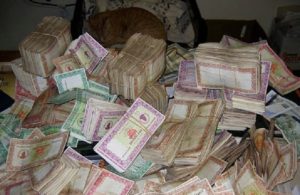You would be hard pressed to find other markets in the world today where an investor can get an almost 600 percent profit by buying into a loss-making company.
The Zimbabwe Stock Exchange (ZSE) is booming, reaching new records each day.
As at yesterday’s closing bell, the market was up 140 percent since January.
The all-share index was a staggering 243 percent higher than it was this time last year.
But instead of bringing cheer and celebration, the bull-run is bringing fear, and an uncomfortable sense of déjà vu.
It’s easy to see why.
A stock market running on fumes and not any real fundamentals, a currency crisis and signs of inflation?
We have seen this all before.
In 2007, just like today, the ZSE became the world’s best performing market.
Shares were up close to 600 percent by mid-year in 2007.
Year-on-year, by April 2007, the stock market had risen a massive 12 000 percent.
We now know it was all a deception; it was only going up because investors had nowhere else to put their Zimbabwe dollars, whose worth was evaporating fast.
Then, as now, it did not matter that a company was performing badly.
General Beltings, a maker of conveyor belts and chemicals, has only managed to narrow its losses in the last year due to the import restrictions.
In the first half 2016, the company’s capacity utilisation was around 11 percent, from 21 percent at the end of 2015.
And yet, as of yesterday, General Beltings is the biggest riser on the market so far this year, up 587 percent since January.
There are many more signs from 2007.
Then, just as now, central bank was all out of ideas about how to solve the currency crisis.
Gideon Gono, three years into his job, was tinkering with the currency, just as John Mangudya today, also in his third year, is battling for a solution.
Around this time in 2007, Gono was stuck between devaluing the currency or losing his job.
The “D word” was an evil term that got ministers fired.
The official rate was Z$250 on the dollar, well overvalued.
Trying to disguise it, Gono introduced what he called a “drought mitigation accelerator factor of 60″.
Under this plan, exporters would be paid 60 times the official rate as an incentive.
It was devaluation by another name.
Still, it never worked.
Today, Mangudya is also in a currency fix.
He has watched his own “export incentive”, the bond note, get devalued on the streets.
Just as importers under Gono had raided the black market for forex, businesses today have to source currency on the informal market.
The foreign payments backlog is now close to a billion dollars.
With no credible forex rate, the Old Mutual Implied Rate – a comparison of Old Mutual share prices in Zimbabwe and those in South Africa and London – became the proxy exchange rate in 2007.
In 2017, the Old Mutual share price is once again being used to gauge the value of the currency in Zimbabwe; the electronic dollars.
In June last year, Old Mutual shares on the ZSE cost some 17.5 percent less than they did in London and on the JSE.
Central bank had increased the fungibility limits on Old Mutual shares to 49 percent from 40 percent, which meant shareholders could move more shares from Zimbabwe to South Africa or London.
However, from that 17.5 percent discount, Old Mutual stock, as of yesterday, has now swung to a 50 percent premium in Zimbabwe.
Once again, just as it did in 2007, the share price is pointing to a virtual devaluation.
For many long-time ZSE watchers, the current bull-run is a scary throwback.
Back in October 2008, at an investment conference organised by Imara, a screen at the venue showed a live feed from ZSE trades.
In the crowd, visiting investors sat with mouths agape as they watched stocks in insurer Zimnat rise 1 150 percent in one session.
On the street, the Zimdollar that same morning was trading at Z$300 million on the US dollar.
Before long, the US dollar was trading at Z$17 billion.
By June 2008, the main ZSE index had reached 900 billion points, from just over 1.2 billion points at the start of that year.
Nobody was watching the index anymore.
Then, just as today, the ZSE was being driven by one major factor; investors anxious to get rid of surplus money in a market where they had few other investment options.
Inflation was estimated at 231 million percent in 2008.
By then, Zimbabwe had run out of inflation; the Government had in 2007 suddenly stopped giving out inflation data, out of embarrassment.
Then, just as now, leaving money in the bank was bad business.
“Why leave money in the bank?” said Emmanuel Munyukwi, who was CEO of the ZSE at the time.
“People are forced to come on the stock market.”
In 2007, the RBZ was running the money printing press round the clock, while today’s central bank does almost the same.
This time, Treasury Bills (TBs) and the RTGS are the new Zimdollars.
With bank assets now made up of a growing pile of TBs, there are questions about banks’ health today, just as there was in 2007 when the banks sat on worthless Zimdollar balances.
That year too, business leaders met Mugabe and, just like in 2017, they achieved nothing beyond plying him with praise.
Cash shortages were just as bad that year; so bad that RBZ ordered banks not to close over one weekend ahead of Christmas.
Even on the political front, matters in 2007 were just as heated as they are today in 2017.
Post published in: Business




Their primary index consists of 58 companies, all of who are probably closely aligned with Mugabe.
“People are forced to come on the stock market.”